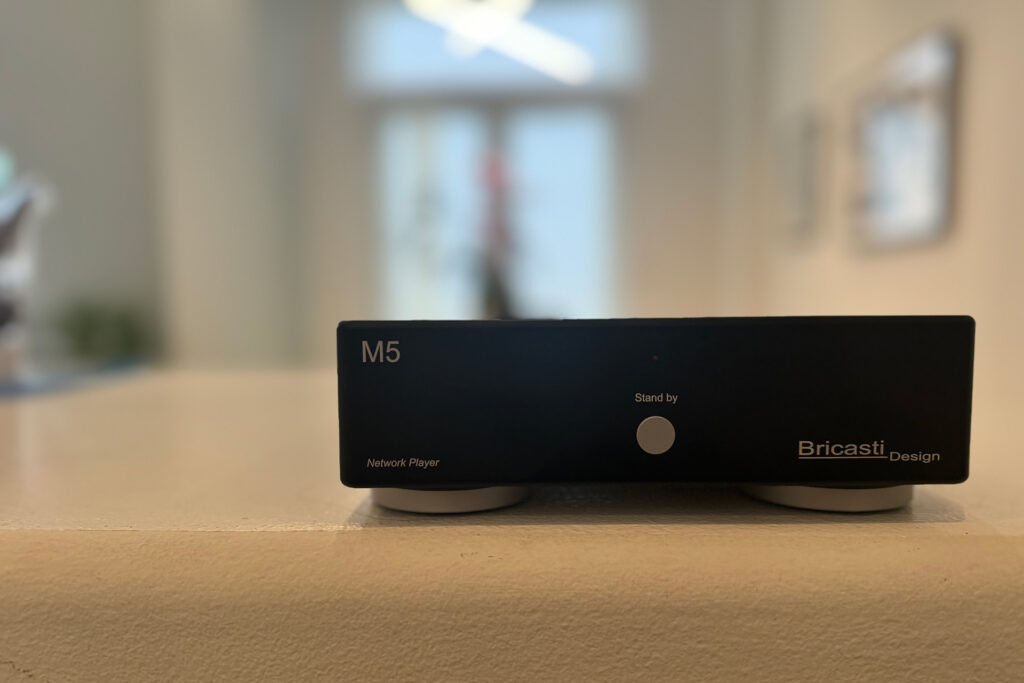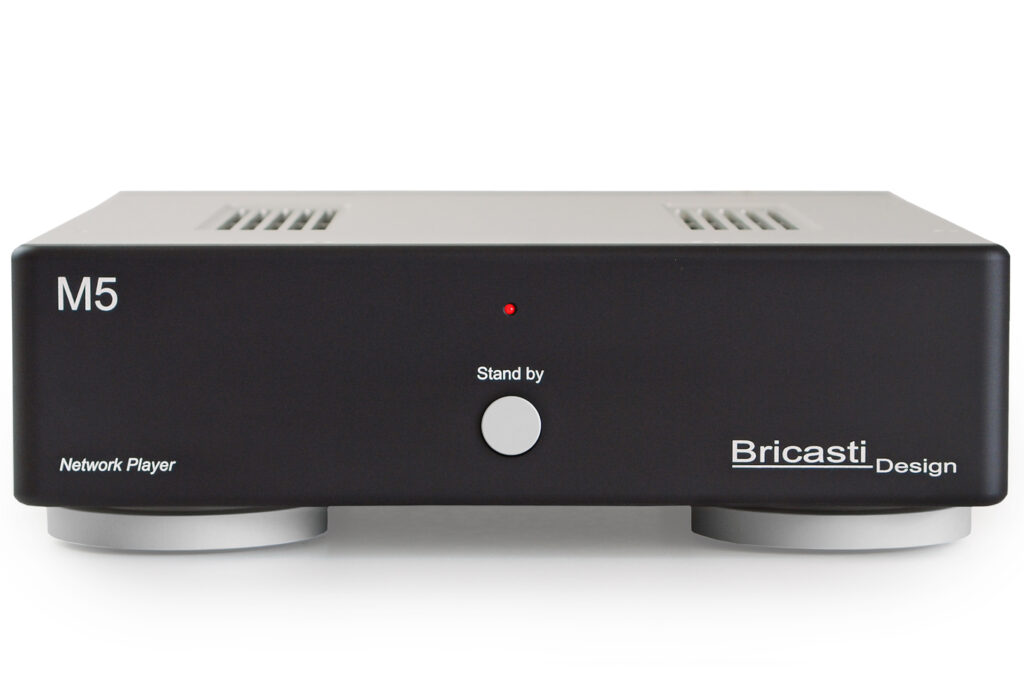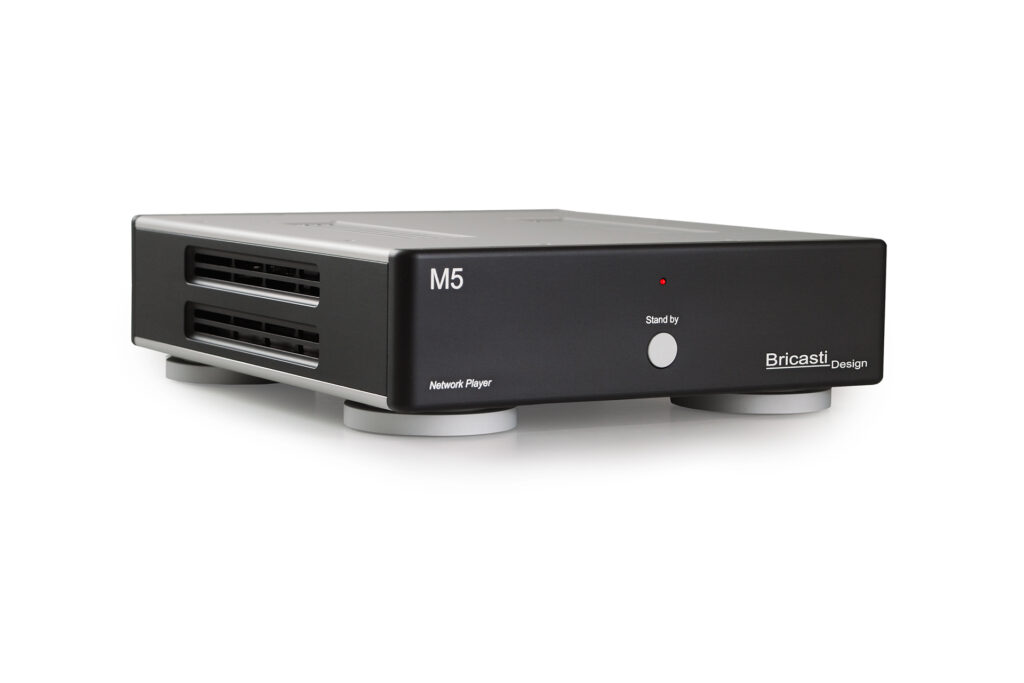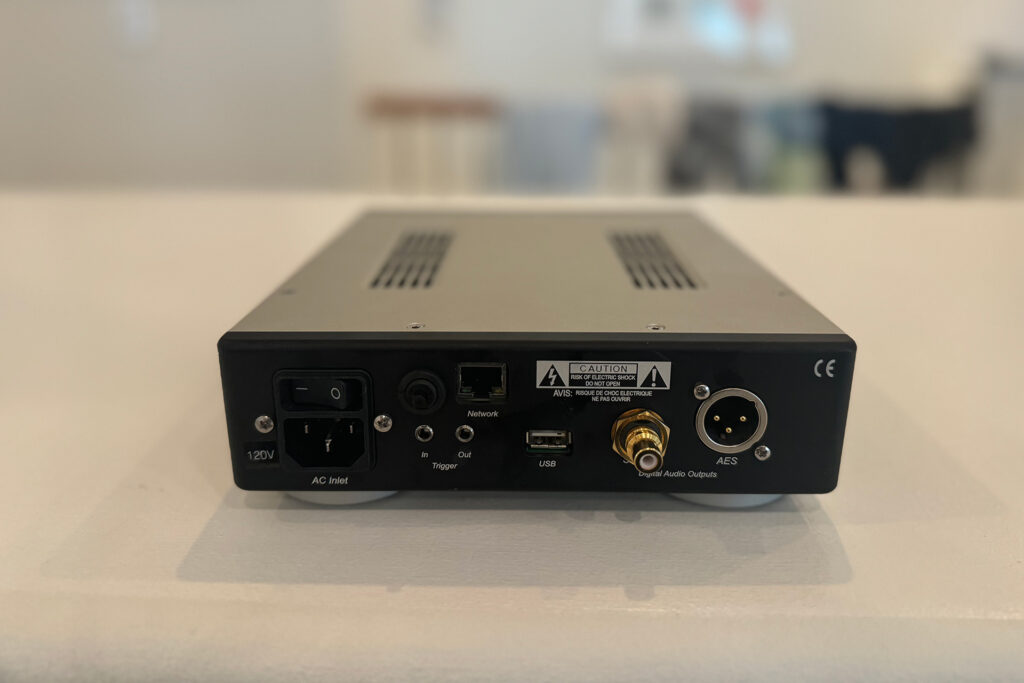One of the big editorial questions that we’ve been discussing here at FutureAudiophile.com in 2024 is, how do you get more performance from a streamer over, say, a BlueSound Node? The Sonos Port has an impressive interface, but not suitable for an audiophile system, in that there is no digital output, thus the quality of their internal DAC (and shared power supply) is the limit of the performance. The new $499 BlueSound Node 2024 (review pending – buy at Crutchfield) has digital outputs, tons of good streaming services, a great user interface, and soon will include Dirac room correction. Respectfully, that’s a hard value proposition to beat. Where an audiophile company will take the hobby to the next level is sonically. That company is Bricasti, and the product is a $2,500 network music streamer called the M5.
The Bricasti M5 is a standalone audiophile network streamer that comes in an anodized aluminum case, with uber-high-end absorbative feet and, at a diminutive half-rack width, can be paired with a small format DAC or other smaller, narrower products on a shelf. The Bricasti M5 works with all three of the music software management software platforms (Roon, AudioNirvana and JRiver). I used Roon (read Brian Kahn’s full guide to Roon here) for my testing. This unit is all about avoiding noise and getting your files opened and played in a way that is least invasive. On paper, that sounds quite promising. From my wallet, a 500 percent increase in price over a mainstream server almost demands that one can hear a notable difference. To date, and having reviewed a number of well-respected audiophile streamers, I am pulling a Blutarski (zero point zero), but I’ve got hope for the Bricasti M5. Major hope …

What Makes the Bricasti M5 Network Streamer So Special?
- The Bricasti M5 is built like a brick shithouse when mainstream music streamers are almost always plastic-y and cheap-feeling to the touch. The Bricasti M5 is made like their other components, such as their audiophile amps, stereo preamps and DACs, thus featuring anodized aluminum casework, super-premium absorbative feet and more.
- The Bricasti M5 streamer shares the same internal power supply as the $10,000+ Bricasti M1 S2 Digital to Analog Converter. Ask any digital audio designer, and they will tell you that the biggest impact to the sound of a GaN amp (learn about Gallium Nitride amps here) or a DAC or any other digital component is the quality/size of the power supply. Can you make a device like the Bricasti M5 work on a way-lesser power supply? Absolutely, you can do that. but it will never sound as good, which is exactly why they use a killer power supply in this diminutive audiophile source component.
- The Bricasti M5 is all about low or no noise. Like an effective yet angry second grade teacher, the Bricasti won’t tolerate noise in the classroom. It deals with this topic via its network Ethernet connection, with files coming in, as well as more broadcast-quality audio output options, such as AES-EBU, which happens to be my digital connection of choice, but is lacking from the aforementioned Sonos Port or, more relevantly, the audiophile reference standard streamer, the BlueSound Node.
- A file doesn’t play until you hit play on the Bricasti M5 via your music management software. This means this streamer isn’t storing your track as much as it is unpacking it and passing said file cleanly from your network drive, through your network, and then unpacking it as painlessly as possible and sending the unpacked digital file to your DAC and then on from there. This isn’t a music server per se. This isn’t a DAC. This isn’t a network hard drive, either. The Bricasti M5 is perhaps better described as an end point.
- The Bricasti M5 supports HD files. These files can be 192k PCM, DSD 64 and DSD 128 and more.
- Bricasti uses an ARM processor that is hand selected and designed to run a music streamer like the Bricasti M5. This processor is a niche product, but uniquely suited to this type of task/role, as I am told by Bricasti’s engineers.
Why Should You Care About the Bricasti M5 Network Streamer?
It is impossible that a $500 streamer is the best that the entire audiophile industry can do in terms of sonic performance, right? Somebody has to have a better solution. These thoughts have gone through your mind if you are shopping for a product in the category of the Bricasti M5. You know that the only way to get as close as possible to the master tape (sorry vinyl, it isn’t even close) is digital audio, and you want to get the most performance from your most important source component.

Some Things You Might Not Like About the Bricasti M5 Network Streamer
- The Bricasti M5 doesn’t have its own operating system, thus it relies on third-party music management software, which supports the big three options (Roon, JRiver or AudioNirvana). In terms of additional hardware, you need something to run this software on something such as a Roon Core or an iMac or a laptop of some sort. I used Roon for music management software in my testing. I can tell you that there is a $15 per month fee attached to that service, and while there’s lots that is cool about Roon – you don’t have a lot of the big players in music streaming. Basically, you are in with QoBuz and Tidal. Pandora, Amazon Music, others? Not with Roon.
- The width of the Bricasti M5 is half-rack. That’s cool if you have other devices to share a rack with your M5. Otherwise, the M5 is the start of your audiophile system, but the component is diminutive and not standardized in terms of size.
- For audiophiles with a Bricasti DAC and/or reviewers like me (I have and love a Bricasti M3 DAC), the Bricasti M5 is seemingly a waste of money. Bricasti will tell you this, too, as the M5 can be integrated via a card into any of the three current Bricasti DACs. Get this – the cost of the card is $1,000 retail! That’s fraction of the price of the Bricasti, M5 thus a better value and possibly a more direct internal connection, so maybe incrementally better performance from the factory card version of the Bricasti Network Streamer (M5).
Listening to the Bricasti M5 Network Streamer …
On the only song that I know inspired by and named after a major North American airport, “YYZ” from Rush’s all-time classic progressive album, Moving Pictures (QoBuz), was an eye/ear-opening experience. From the discordant chords and percussive guitar chops that open the track, I could hear a wider soundstage and more detail from this familiar piece with the Bricasti M5 in the loop. The snap in the whip used later in the track had a little more CRACK to it than on other more mainstream servers. Geddy Lee’s bass, during the guitar solo, had more mostly low-frequency detail that I could hear on other streamers. The Bricasti M5 took me incrementally closer to the original recording for the first time in over a year of testing more upmarket streamers. This is quite encouraging after a lot of testing and a lot of searching.
On “Out to Get Me,” a somewhat deep track from Guns and Roses’ Appetite For Destruction (QoBuz), was another ear-opener, as that wonderful guitar distortion/burn that you hear in the intro just sounded more engaging and real with the Bricasti M5 in my system. The guitar sound on lesser streamers sounded more folded-down or one-dimensional. Often, the most obvious ways to come to a conclusion in a test like this is to switch back to the lesser expensive option. When I did, the differences seemed more obvious, even with the volume matched, using the same track from the same streaming service.
On “Rock with You” from Michael Jackson’s disco-ey Off The Wall record (QoBuz), you could hear the tight guitar playing with more emphasis (detail you can hear) on the percussive guitar part of the song. I liked how deep the layered, overdubbed Michael vocals sounded in the chorus of the track. The pops and slaps of the bass guitar had just a modicum more attack with the Bricasti – something that again was best heard when going back to the other streamer and comparing the slight differences.
Will the Bricasti M5 Hold Its Value?
Bricasti components hold their value fantastically well, as there is both a professional audio clientele and a growing and highly loyal audiophile fan base. Bricasti gear isn’t made in large volumes, so when one comes up on the used market, said audiophile components tend to sell almost instantaneously. Bricasti also is good about upgrades, which makes your components more and more relevant over time. So, yes, the Bricasti M5 will hold its value as well as any other music streamer that we can think of.

What Is the Competition for the Bricasti M5 Network Streamer?
The PS Audio AirLens ($1,999 – read the review) is a sold-direct music streamer that our in-house streamer expert, Greg Handy, recently raved about. This was the first streamer of any kind that either of us tested that could provide any level of audible difference over something like a BlueSound Node. Again, you are relying on outside music management software, but that can be an advantage for some. For example, Roon has absolutely fantastic meta data that allows an audiophile to follow musical threads in truly unique ways.
The Lumin D3 Streamer and DAC (click to read the review) is a $2,600 comparison for the Bricasti M5 in a slightly offbeat way. While the Bricasti doesn’t have a DAC internally, the two companies both have professional audio or broadcast lineage. Both products are quite well-built, with the Bricasti offering better output options. The internal DAC in the Lumin is not too dissimilar to our house favorite CHI-FI DAC, the Topping D90 III Sabre (read the review here).
The BlueSound Node 2024 – $499 We’ve mentioned the BlueSound Node in this review a bunch of times. What we didn’t say was that the new 2024 version of the Node isn’t more expensive, but it comes with a much better power supply, as well as (coming in January 2025, I was just told) Dirac Live room correction software. This is a major deal, in that you can add optional high-end mic-calibrated digital room correction from an entry-level audiophile component. BluOS is fully worked-out and Sonos-level good. The Node doesn’t offer AES-EBU output to your DAC, but it does have nearly every streaming service supported, which make it only comparable with the Sonos Port.

Final Thoughts on the Bricasti M5 Network Streamer …
Finally! At long last, I have found a music streamer that delivers on the promise of better sonics than the best of the mainstream streamers. It isn’t shocking that Bricasti was the company to figure it out, as they have just the types of engineers to get down to brass tacks (removing noise, I guess, is a big deal) and make a streaming device or endpoint that can deliver a more master tape-quality sound.
What component is more important to the overall performance of your audiophile system than your streamer? This is the technical start of the audio journey for your music, and it turns out that there is a little bit more performance to be had if you have the interest and budget to test out something like the Bricasti M5 network steamer. As our systems get better and better over time, and with significant investment, there are fewer places to find audiophile upgrades that make a noticeable difference or that make financial sense. An upgrade (or addition, in my case) of a Bricasti M5 might get you to that higher level of streaming or network audio excellence, all at a price that is well within industry norms and sensibilities.
The Bricasti M5 delivered on the long-standing question of what streamer was going to best the sound of mainstream, lower-cost units. I was starting to think that there wasn’t ever going to be a sonic difference between the feature-laden consumer electronics-level units versus more audiophile-grade or professional audio components. Now we can report that the next level of performance is there for the having if you are looking to make your audiophile race car go just a little bit faster, and that comes in the form of the Bricasti M5 network streamer, which is simply a top-performing, well-engineered solution that is going to tempt many an audiophile, and for damn good reason.




I’m confused by the beginning of this article because the Sonos port does have a coax digital output. Are you saying that in someway it’s not actually digital?
My older Sonos Ports have no digital out. Perhaps the new ones do? Not sure, I have 9 of the older ones and I am not in the mood to buy 9 more 🙂